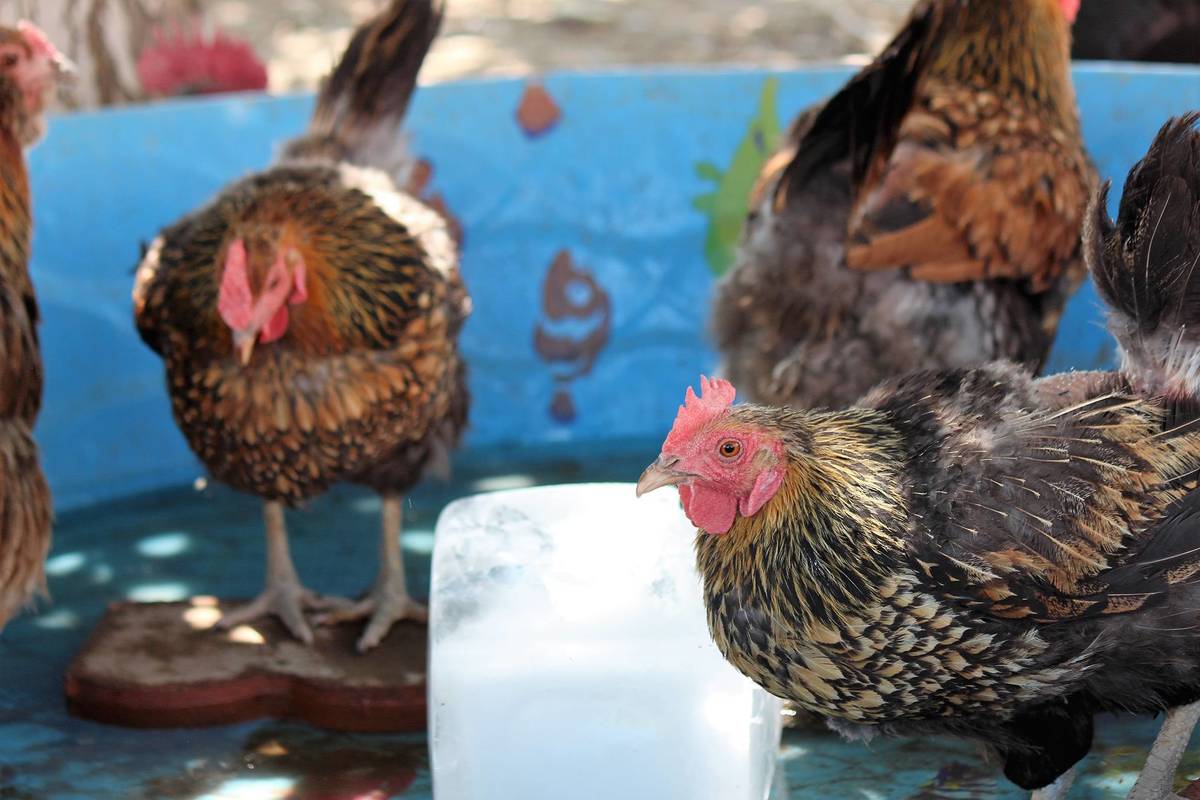
Chickens were first domesticated sometime around 2000 B.C. and originated from wild jungle fowl near Southeast Asia.
You would think that coming from a jungle environment, chickens would be well equipped to handle the heat. Surprisingly, modern day domesticated chickens are most comfortable at a temperature of around 75 degrees. Keeping them comfortable can certainly be a challenge when our summer days easily top 115 degrees. With a few simple steps you can help keep your chickens comfortable through the dog days of summer.
Five tips for keeping chickens cool when temperatures soar:
Provide shade
This is a no-brainer but easier said than done. If you are fortunate to have a large tree with low-hanging branches and soft soil you will find that your chickens navigate there naturally.
If you don’t have a suitable tree you will need to build a structure to provide shade. For those that do not free range this could include something as simple as putting a shade cloth over your existing chicken run. I prefer to shade with vines that grow up the structure and drop their leaves in the winter. This allows the sun in for warmth during the cool season.
I have experimented in the past with building a Quonset hut-style shade structure by lashing together thick bamboo poles and palm fronds that a neighbor had trimmed from their trees. The structure proved to be popular with my chickens and held up surprisingly well through the wild winds we sometimes get.
Water, water, water
Chickens should be provided with multiple sources of water, especially if you are not home during large parts of the day. The water should be kept in a semi-enclosed container in the shade.
My favorite container to use is a 5-gallon waterer designed specifically for poultry that can be filled from the top. I prop them up on concrete blocks to keep the water clean. In the summer I freeze water in quart-size recycled containers to make a nice sized ice brick that I can place into the chicken waterer. Chickens are more likely to drink the water if it is not hot.
A portable mister can help keep the temperature down for your chickens as well. Even if your chickens choose not to stand directly in the mister, it will bring down the temperature a bit, especially in an enclosed space like a coop.
Frozen treats
I have never met a chicken who would pass up watermelon, especially frozen watermelon. Other frozen fruit such as strawberries and raspberries are also great options. Avoid frozen corn, seeds, and legumes as they take longer for a chicken to digest and that warms the body. When cutting up fruit to freeze for chickens keep in mind that the larger the piece of fruit is, the longer it will take for your chickens to nibble. This will be more effective for keeping them cool as well as the bonus of serving as a boredom buster.
Fans and ventilation
Enclosed coops should be well ventilated. If you are able to, put windows on opposite sides of your coop. In the summer the windows can be left open and should be covered with a wire mesh screening to keep pests and predators out of the coop. Smaller screened vents could also be placed below the roost where the chickens sleep at night. When there is a gentle breeze an updraft is created from the bottom vents to the upper windows helping to cool the coop.
If you have power to your coop you might want to consider installing a box fan rated for outdoor use. Be sure that your box fan does not have large openings that the chickens could become caught in. You can also reinforce the fan by placing tight wire mesh over the grates to further ensure your chickens’ safety.
Baby pools
Large plastic baby pools are popular among chicken keepers. I like to take things one step further. Chickens are not always a fan of standing in water all day and it can cause problems for their feet and health. I place pavestones in my baby pool for the chickens to stand on. I fill the pool with water just up to the top of the pavestones without covering them.
When temperatures are at their most extreme, over 105 degrees, I fill gallon-sized ice cream containers with water and freeze to create ice bricks. During the hottest part of the day I pop the ice bricks into the pool to cool the water. The water cools the pavestones and the pavestones cool the chickens. I have the baby pool under a large tree with shade through the entire day.
Every week I dump out the baby pools and scrub them well, letting them dry in the sun. This prevents a build-up of mold and reduces potential disease from water-borne illness. The chickens enjoy this process as there are always plenty of bugs for them to consume beneath the pool in the moist soil. When they see me about to turn the pool, they flock to surround it. A frenzy ensues, which is always fun to watch.
This method may seem like a lot of work and fuss to go through for chickens, but it takes me less than 10 minutes a day and I have never lost a chicken due to the heat. To me it’s a minimal amount of time to protect the long-term investment that I’ve made on my farm. The investment is repaid many times over in fresh and delicious eggs served with a side of entertainment.
Terri Meehan is the Founder of Southern Nevada Gardening Association a regional group. She is a garden mentor and local farmer in Pahrump. Send questions or comments to her at sonvgarden@gmail.com